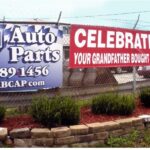The Lincoln Town Car, especially models from the late 90s, holds a special place for those appreciating American luxury and robust engineering. If you’re maintaining or restoring a 1998 Lincoln Town Car, understanding parts compatibility and availability is crucial. This guide delves into what you need to know about sourcing 98 Lincoln Town Car Parts, ensuring you keep this classic running smoothly.
Understanding the Panther Platform and Your 1998 Town Car
The 1998 Lincoln Town Car is built on the Ford Panther platform, a rear-wheel-drive architecture shared with other iconic vehicles like the Ford Crown Victoria and Mercury Grand Marquis. This platform consistency from 1998 to 2002, and even beyond with later iterations, means certain components are interchangeable within this range. However, it’s not a blanket rule, especially when considering body panels and trim.
For 98 lincoln town car parts, focusing on components specific to the 1998-2002 “third generation” Town Car is generally advisable for direct fitment. This generation maintained a consistent design, making parts sourcing relatively straightforward within these model years for mechanical and chassis components.
Navigating Parts Compatibility: 1998-2002 vs. 2003+
While the Panther platform remained the foundation, significant updates occurred in 2003. The chassis, steering, and crucially, the body, were redesigned. Although the wheelbase remained consistent, dimensions like length, width, and height changed slightly from the 2002 to 2003 models.
This brings up an important point regarding body parts, particularly the front end. The question often arises: can you interchange front-end sheet metal, like the “front clip,” between a 1998-2002 Town Car and a 2003 or later model?
Theoretically, due to the Panther platform’s underlying similarities, some modifications might allow for a front-end swap. The radiator core support is often cited as a key structural element. If the core support is compatible or adaptable, it opens possibilities for fitting other front-end sheet metal components.
However, it’s essential to understand that such a modification is far from a simple “bolt-on” process. It would demand significant skill, time, and potentially custom fabrication to achieve a seamless and aesthetically pleasing result. While examples might exist of such swaps, the fit and finish up close can vary, and the level of effort should not be underestimated.
Furthermore, even if 2003 parts could be adapted, considering parts from later years like 2010 might present fewer differences compared to the 2002-2003 change, but the core principle of modification complexity remains.
Sourcing 98 Lincoln Town Car Parts: What to Consider
When looking for 98 lincoln town car parts, consider these factors:
- Type of Part: Mechanical parts (engine, transmission, suspension) often have broader compatibility within the Panther platform years. Body parts (bumpers, fenders, lights) are more generation-specific.
- New vs. Used: Depending on the part and your budget, you might consider new aftermarket parts, OEM (Original Equipment Manufacturer) surplus, or used parts from reputable sources.
- Source Reliability: For used parts, especially, ensure you are dealing with a trusted vendor or salvage yard to guarantee part quality and condition.
- DIY vs. Professional Installation: Assess your mechanical skills. While routine maintenance parts are DIY-friendly, more complex components or modifications might require professional installation.
Conclusion: Time and Resources for Your Town Car Project
Modifying or extensively repairing a classic like a 1998 Lincoln Town Car is often a labor of love. While the Panther platform provides a degree of parts commonality, especially for mechanical components, body modifications and swaps require careful planning and execution.
Ultimately, when considering significant modifications or sourcing specific 98 lincoln town car parts, remember the adage: “Anything can be done with enough time and money.” The key is to realistically assess your resources and skills to ensure your project is both achievable and enjoyable.
